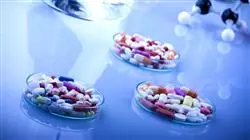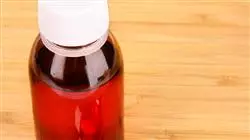University certificate
The world's largest faculty of pharmacy”
Introduction to the Program
Improve your knowledge in the Elaboration and Development of Individualized Medicines through this program, where you will find the best teaching material with real clinical cases. Find out about the latest advances in the speciality here, in order to be able to carry out quality clinical practice"

The Master Formulation or, nowadays, "individualized medicine" is the essence of the pharmaceutical profession. It has been the starting point of human medicine therapeutics, when patient care was itemized.
The magistral formula understood as the medicine intended for an individualized patient, prepared by a pharmacist or under his direction, to expressly fulfill a detailed medical prescription of the medicinal substances that includes, requires that the professional activity conform to strict and faithfully reproducible procedural guidelines. In this sense, pharmacists need to be up to date and promote continuous training in the knowledge and compliance with the standards for the correct preparation and quality control of master formulas in order to achieve the required level of quality.
The main objective of the Professional master’s degree in Elaboration and Development of Individualized Medicines is to train pharmacists in a unique and exclusive discipline of their profession, specializing professionals who can respond to therapeutic gaps with the formulation of an individualized medicine with the quality and efficacy of an industrialized medicine.
In this sense, the Professional master’s degree is structured in four specific blocks, focused on the Elaboration and Development of Individualized Medicines, as well as the current legislation and the rules for the correct elaboration of master formulas and officinal preparations.
These theoretical modules will be accompanied by videos of the elaboration of different master formulas prepared by professionals, where the student will be able to visualize the modus operandi of each one of them.
Update your knowledge through the Professional master’s degree in Professional master’s degree"
This Professional master’s degree in Elaboration and Development of Individualized Medicines contains the most complete and up-to-date scientific program on the market. The most important features of the program include:
- Development of more than 50 clinical cases presented by experts in Master Formula
- The graphic, schematic, and practical contents with which they are created provide scientific and practical information on the disciplines that are essential for professional
- Contains practical exercises where the self-evaluation process can be carried out to improve learning
- An algorithm-based interactive learning system for decision-making in the clinical situations presented throughout the course
- Special emphasis on evidence-based medicine and research methodologies in the Elaboration and Development of Individualized Medicines
- All of this will be complemented by theoretical lessons, questions to the expert, debate forums on controversial topics, and individual reflection assignments
- Availability of content from any fixed or portable device with internet connection
This Professional master’s degree is the best investment you can make in the selection of a refresher program for two reasons: in addition to updating your knowledge in Elaboration and Development of Individualized Medicines, you will obtain a certificate issued by TECH Global University”
The teaching staff includes professionals from the field of master formulation, who bring their experience to this training program, as well as renowned specialists from leading scientific societies.
Thanks to its multimedia content developed with the latest educational technology, it will allow the professional a situated and contextual learning, that is to say, a simulated environment that will provide an immersive learning programmed to train in real situations.
The design of this program focuses on Problem-Based Learning, through which the pharmaceutical professional should try to solve the different situations of professional practice that arise during the course. For this purpose, it will be assisted by an innovative interactive video system created by renowned experts in the field of the Elaboration and Development of Individualized Medicines with extensive teaching experience.
Increase your decision-making confidence by updating your knowledge through this Professional master’s degree"

This Professional master’s degree will generate a sense of confidence when performing clinical practice, which will help you to grow personally and professionally"
Why study at TECH?
TECH is the world’s largest online university. With an impressive catalog of more than 14,000 university programs available in 11 languages, it is positioned as a leader in employability, with a 99% job placement rate. In addition, it relies on an enormous faculty of more than 6,000 professors of the highest international renown.

Study at the world's largest online university and guarantee your professional success. The future starts at TECH”
The world’s best online university according to FORBES
The prestigious Forbes magazine, specialized in business and finance, has highlighted TECH as “the world's best online university” This is what they have recently stated in an article in their digital edition in which they echo the success story of this institution, “thanks to the academic offer it provides, the selection of its teaching staff, and an innovative learning method aimed at educating the professionals of the future”
A revolutionary study method, a cutting-edge faculty and a practical focus: the key to TECH's success.
The most complete study plans on the university scene
TECH offers the most complete study plans on the university scene, with syllabuses that cover fundamental concepts and, at the same time, the main scientific advances in their specific scientific areas. In addition, these programs are continuously being updated to guarantee students the academic vanguard and the most in-demand professional skills. In this way, the university's qualifications provide its graduates with a significant advantage to propel their careers to success.
TECH offers the most comprehensive and intensive study plans on the current university scene.
A world-class teaching staff
TECH's teaching staff is made up of more than 6,000 professors with the highest international recognition. Professors, researchers and top executives of multinational companies, including Isaiah Covington, performance coach of the Boston Celtics; Magda Romanska, principal investigator at Harvard MetaLAB; Ignacio Wistumba, chairman of the department of translational molecular pathology at MD Anderson Cancer Center; and D.W. Pine, creative director of TIME magazine, among others.
Internationally renowned experts, specialized in different branches of Health, Technology, Communication and Business, form part of the TECH faculty.
A unique learning method
TECH is the first university to use Relearning in all its programs. It is the best online learning methodology, accredited with international teaching quality certifications, provided by prestigious educational agencies. In addition, this disruptive educational model is complemented with the “Case Method”, thereby setting up a unique online teaching strategy. Innovative teaching resources are also implemented, including detailed videos, infographics and interactive summaries.
TECH combines Relearning and the Case Method in all its university programs to guarantee excellent theoretical and practical learning, studying whenever and wherever you want.
The world's largest online university
TECH is the world’s largest online university. We are the largest educational institution, with the best and widest online educational catalog, one hundred percent online and covering the vast majority of areas of knowledge. We offer a large selection of our own degrees and accredited online undergraduate and postgraduate degrees. In total, more than 14,000 university degrees, in eleven different languages, make us the largest educational largest in the world.
TECH has the world's most extensive catalog of academic and official programs, available in more than 11 languages.
Google Premier Partner
The American technology giant has awarded TECH the Google Google Premier Partner badge. This award, which is only available to 3% of the world's companies, highlights the efficient, flexible and tailored experience that this university provides to students. The recognition as a Google Premier Partner not only accredits the maximum rigor, performance and investment in TECH's digital infrastructures, but also places this university as one of the world's leading technology companies.
Google has positioned TECH in the top 3% of the world's most important technology companies by awarding it its Google Premier Partner badge.
The official online university of the NBA
TECH is the official online university of the NBA. Thanks to our agreement with the biggest league in basketball, we offer our students exclusive university programs, as well as a wide variety of educational resources focused on the business of the league and other areas of the sports industry. Each program is made up of a uniquely designed syllabus and features exceptional guest hosts: professionals with a distinguished sports background who will offer their expertise on the most relevant topics.
TECH has been selected by the NBA, the world's top basketball league, as its official online university.
The top-rated university by its students
Students have positioned TECH as the world's top-rated university on the main review websites, with a highest rating of 4.9 out of 5, obtained from more than 1,000 reviews. These results consolidate TECH as the benchmark university institution at an international level, reflecting the excellence and positive impact of its educational model.” reflecting the excellence and positive impact of its educational model.”
TECH is the world’s top-rated university by its students.
Leaders in employability
TECH has managed to become the leading university in employability. 99% of its students obtain jobs in the academic field they have studied, within one year of completing any of the university's programs. A similar number achieve immediate career enhancement. All this thanks to a study methodology that bases its effectiveness on the acquisition of practical skills, which are absolutely necessary for professional development.
99% of TECH graduates find a job within a year of completing their studies.
Professional Master's Degree in Elaboration and Development of Individualized Medicines
It is not only a matter of indicating the name of a certain antibiotic or analgesic, the prescription of drugs has its own particularities: if a geriatric patient has swallowing problems and it is impossible for him to take his pills or the medication for a certain pathology in pediatrics exists only in adult doses, how do pharmacists address such issues? For this there is the so-called magistral formula that you can learn in the Professional Master's Degree in Elaboration and Development of Individualized Medicines of TECH Global University, a great complementary option to your studies that combines a select agenda with the latest advances in digital platforms and methodological systems for teaching, configuring a completely new online program. Located on the podium of online education worldwide, we provide a first class training with the best teaching staff you will find in the market. In this Postgraduate Certificate you will find from the legal aspects of individualized formulation to basic physicochemical operations: a compendium of unique knowledge to enhance your career.
Prepare individualized medications with this Professional Master's Degree
The ancient apothecaries were basically chefs who, rather than impacting the palate, sought out the best ingredients to attack the body's ailments. In their hands, an infusion became an effective mucolytic or a powdered plant a notorious antihistamine. Today, scientific and technological evolution has changed the rules of the game, but this does not mean that the pharmaceutical industry is endowed with infallibility. Certain posological and therapeutic gaps require personalized medication, which is the basis of the master formula, creating a new drug through existing active ingredients. With this Professional Master's Degree you will be able to develop optimally in this field. Throughout the 1500 hours of the program, which you can manage according to your time availability, we will teach you about topics such as pharmacy and pharmacokinetics, pharmaceutical forms of topical administration, essential oils of magistral formulation, among others. Using dynamics of academic immersion and interactive multimedia, we bring you closer to a professionalization that you cannot miss.







